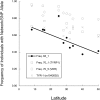Latitudinal Clines of the Human Vitamin D Receptor and Skin Color Genes
- PMID: 26921301
- PMCID: PMC4856077
- DOI: 10.1534/g3.115.026773
Latitudinal Clines of the Human Vitamin D Receptor and Skin Color Genes
Abstract
The well-documented latitudinal clines of genes affecting human skin color presumably arise from the need for protection from intense ultraviolet radiation (UVR) vs. the need to use UVR for vitamin D synthesis. Sampling 751 subjects from a broad range of latitudes and skin colors, we investigated possible multilocus correlated adaptation of skin color genes with the vitamin D receptor gene (VDR), using a vector correlation metric and network method called BlocBuster. We discovered two multilocus networks involving VDR promoter and skin color genes that display strong latitudinal clines as multilocus networks, even though many of their single gene components do not. Considered one by one, the VDR components of these networks show diverse patterns: no cline, a weak declining latitudinal cline outside of Africa, and a strong in- vs. out-of-Africa frequency pattern. We confirmed these results with independent data from HapMap. Standard linkage disequilibrium analyses did not detect these networks. We applied BlocBuster across the entire genome, showing that our networks are significant outliers for interchromosomal disequilibrium that overlap with environmental variation relevant to the genes' functions. These results suggest that these multilocus correlations most likely arose from a combination of parallel selective responses to a common environmental variable and coadaptation, given the known Mendelian epistasis among VDR and the skin color genes.
Keywords: adaptation; epistasis; linkage disequilibrium; network analysis; skin color; vitamin D.
Copyright © 2016 Tiosano et al.
Figures





References
-
- Abd-Allah S. H., Pasha H. F., Hagrass H. A., Alghobashy A. A., 2014. Vitamin D status and vitamin D receptor gene polymorphisms and susceptibility to type 1 diabetes in Egyptian children. Gene 536: 430–434. - PubMed
-
- Arai H., Miyamoto K. I., Yoshida M., Yamamoto H., Taketani Y., et al. , 2001. The polymorphism in the caudal-related homeodomain protein Cdx-2 binding element in the human vitamin D receptor gene. J. Bone Miner. Res. 16: 1256–1264. - PubMed
Publication types
MeSH terms
Substances
Grants and funding
LinkOut - more resources
Full Text Sources
Other Literature Sources
